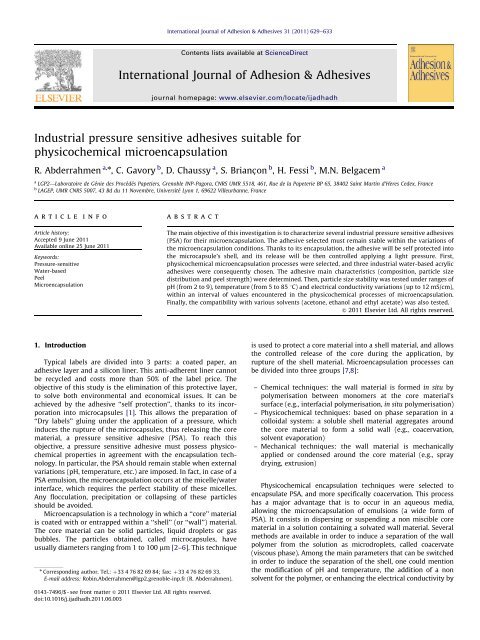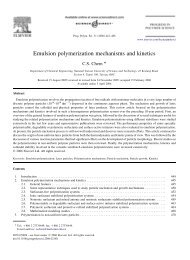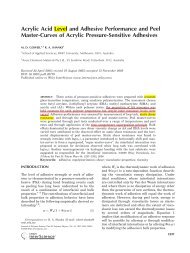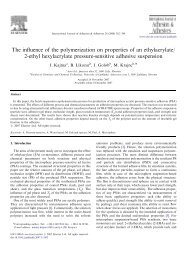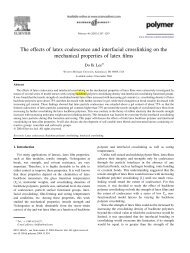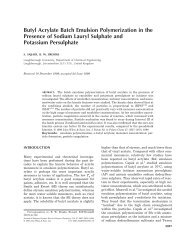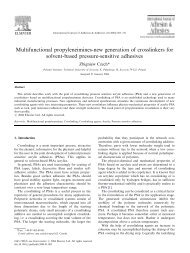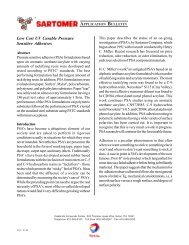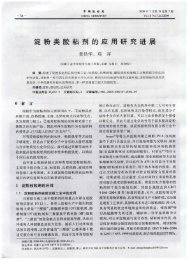Industrial pressure sensitive adhesives suitable for physicochemical ...
Industrial pressure sensitive adhesives suitable for physicochemical ...
Industrial pressure sensitive adhesives suitable for physicochemical ...
Create successful ePaper yourself
Turn your PDF publications into a flip-book with our unique Google optimized e-Paper software.
International Journal of Adhesion & Adhesives 31 (2011) 629–633<br />
Contents lists available at ScienceDirect<br />
International Journal of Adhesion & Adhesives<br />
journal homepage: www.elsevier.com/locate/ijadhadh<br />
<strong>Industrial</strong> <strong>pressure</strong> <strong>sensitive</strong> <strong>adhesives</strong> <strong>suitable</strong> <strong>for</strong><br />
<strong>physicochemical</strong> microencapsulation<br />
R. Abderrahmen a,n , C. Gavory b , D. Chaussy a , S. Brianc-on b , H. Fessi b , M.N. Belgacem a<br />
a LGP2—Laboratoire de Génie des Procédés Papetiers, Grenoble INP-Pagora, CNRS UMR 5518, 461, Rue de la Papeterie BP 65, 38402 Saint Martin d’Heres Cedex, France<br />
b LAGEP, UMR CNRS 5007, 43 Bd du 11 Novembre, Université Lyon 1, 69622 Villeurbanne, France<br />
article info<br />
Article history:<br />
Accepted 9 June 2011<br />
Available online 25 June 2011<br />
Keywords:<br />
Pressure-<strong>sensitive</strong><br />
Water-based<br />
Peel<br />
Microencapsulation<br />
abstract<br />
The main objective of this investigation is to characterize several industrial <strong>pressure</strong> <strong>sensitive</strong> <strong>adhesives</strong><br />
(PSA) <strong>for</strong> their microencapsulation. The adhesive selected must remain stable within the variations of<br />
the microencapsulation conditions. Thanks to its encapsulation, the adhesive will be self protected into<br />
the microcapsule’s shell, and its release will be then controlled applying a light <strong>pressure</strong>. First,<br />
<strong>physicochemical</strong> microencapsulation processes were selected, and three industrial water-based acrylic<br />
<strong>adhesives</strong> were consequently chosen. The adhesive main characteristics (composition, particle size<br />
distribution and peel strength) were determined. Then, particle size stability was tested under ranges of<br />
pH (from 2 to 9), temperature (from 5 to 85 1C) and electrical conductivity variations (up to 12 mS/cm),<br />
within an interval of values encountered in the <strong>physicochemical</strong> processes of microencapsulation.<br />
Finally, the compatibility with various solvents (acetone, ethanol and ethyl acetate) was also tested.<br />
& 2011 Elsevier Ltd. All rights reserved.<br />
1. Introduction<br />
Typical labels are divided into 3 parts: a coated paper, an<br />
adhesive layer and a silicon liner. This anti-adherent liner cannot<br />
be recycled and costs more than 50% of the label price. The<br />
objective of this study is the elimination of this protective layer,<br />
to solve both environmental and economical issues. It can be<br />
achieved by the adhesive ‘‘self protection’’, thanks to its incorporation<br />
into microcapsules [1]. This allows the preparation of<br />
‘‘Dry labels’’ gluing under the application of a <strong>pressure</strong>, which<br />
induces the rupture of the microcapsules, thus releasing the core<br />
material, a <strong>pressure</strong> <strong>sensitive</strong> adhesive (PSA). To reach this<br />
objective, a <strong>pressure</strong> <strong>sensitive</strong> adhesive must possess <strong>physicochemical</strong><br />
properties in agreement with the encapsulation technology.<br />
In particular, the PSA should remain stable when external<br />
variations (pH, temperature, etc.) are imposed. In fact, in case of a<br />
PSA emulsion, the microencapsulation occurs at the micelle/water<br />
interface, which requires the perfect stability of these micelles.<br />
Any flocculation, precipitation or collapsing of these particles<br />
should be avoided.<br />
Microencapsulation is a technology in which a ‘‘core’’ material<br />
is coated with or entrapped within a ‘‘shell’’ (or ‘‘wall’’) material.<br />
The core material can be solid particles, liquid droplets or gas<br />
bubbles. The particles obtained, called microcapsules, have<br />
usually diameters ranging from 1 to 100 mm [2–6]. This technique<br />
n Corresponding author. Tel.: þ33 4 76 82 69 84; fax: þ33 4 76 82 69 33.<br />
E-mail address: Robin.Abderrahmen@lgp2.grenoble-inp.fr (R. Abderrahmen).<br />
is used to protect a core material into a shell material, and allows<br />
the controlled release of the core during the application, by<br />
rupture of the shell material. Microencapsulation processes can<br />
be divided into three groups [7,8]:<br />
– Chemical techniques: the wall material is <strong>for</strong>med in situ by<br />
polymerisation between monomers at the core material’s<br />
surface (e.g., interfacial polymerisation, in situ polymerisation)<br />
– Physicochemical techniques: based on phase separation in a<br />
colloidal system: a soluble shell material aggregates around<br />
the core material to <strong>for</strong>m a solid wall (e.g., coacervation,<br />
solvent evaporation)<br />
– Mechanical techniques: the wall material is mechanically<br />
applied or condensed around the core material (e.g., spray<br />
drying, extrusion)<br />
Physicochemical encapsulation techniques were selected to<br />
encapsulate PSA, and more specifically coacervation. This process<br />
has a major advantage that is to occur in an aqueous media,<br />
allowing the microencapsulation of emulsions (a wide <strong>for</strong>m of<br />
PSA). It consists in dispersing or suspending a non miscible core<br />
material in a solution containing a solvated wall material. Several<br />
methods are available in order to induce a separation of the wall<br />
polymer from the solution as microdroplets, called coacervate<br />
(viscous phase). Among the main parameters that can be switched<br />
in order to induce the separation of the shell, one could mention<br />
the modification of pH and temperature, the addition of a non<br />
solvent <strong>for</strong> the polymer, or enhancing the electrical conductivity by<br />
0143-7496/$ - see front matter & 2011 Elsevier Ltd. All rights reserved.<br />
doi:10.1016/j.ijadhadh.2011.06.003
630<br />
R. Abderrahmen et al. / International Journal of Adhesion & Adhesives 31 (2011) 629–633<br />
the addition of a salt. The coacervate will then deposit on the core’s<br />
surface to <strong>for</strong>m its shell. Finally, the wall is hardened by crosslinking<br />
[9–12].<br />
A <strong>pressure</strong> <strong>sensitive</strong> adhesive (PSA) is a material that adheres<br />
instantaneously to solid surfaces, with the application of a light<br />
<strong>pressure</strong> [13–15]. They are polymers based, with usually a<br />
complex <strong>for</strong>mulation (additives, as plasticizers or resins) [16].<br />
They are widely used in many industries, as tapes, labels or<br />
protective films. The three main properties determining PSA<br />
per<strong>for</strong>mances are the tack, the peel strength and the shear<br />
resistance [17–19]. Tack is the ability to bond rapidly, when it is<br />
pressed against the surface of a substrate. Peel strength is the<br />
<strong>for</strong>ce required to peel away a tape from a substrate, under<br />
standards conditions (angle test 901 or 1801). Shear resistance is<br />
the internal cohesive strength (ability of a PSA to withstand<br />
creep). PSAs can be divided into four classes: solvent-based,<br />
water-based, hot melt or radiation-cured PSA. Two of them are<br />
mainly used in the labelling industry, because of good adhesive<br />
per<strong>for</strong>mances and low prices: hot-melt [20,21] and water-based<br />
PSAs [22]. A hot-melt PSA is composed of thermoplastic polymers.<br />
It has the advantage to be solvent free, i.e., 100% solid. However, it<br />
involves high viscosity processing conditions (viscosity from 1000<br />
to 3000 mPa s) [23]. This thermoplastic adhesive requires heating<br />
to be processed. A water-based PSA is composed of polymers in<br />
emulsion: acrylic, latex, rubber, etc. Its solid content is usually<br />
from 40 to 60% wt. It has the advantage to be in aqueous media,<br />
with a lower viscosity (viscosity from 200 to 600 mPa s [23]),<br />
whereas a solvent is required (e.g., heptane) to reduce hot-melt<br />
viscosity (which causes some organic volatile compounds (OVC)<br />
drawbacks, with respect to environmental issues). Thus, waterbased<br />
PSAs were selected <strong>for</strong> this investigation.<br />
2. Experimental<br />
2.1. Adhesives main characteristics:<br />
Three water-based PSA emulsions from SEALOCK were selected.<br />
They are used in the labelling industry. They are all acrylic-based<br />
emulsions, with anionic surfactant. Indeed, PSA 1 and PSA 3 are<br />
composed of acrylic co-polymer and rosin, whereas in PSA 2 main<br />
compound is acrylic resin. For each adhesive, pH and electrical<br />
conductivity were first measured. Dry content was also determined,<br />
after drying at 100 1Cinanoven<strong>for</strong>48h.Thechemicalcompositions<br />
were carried out by fourier trans<strong>for</strong>m infrared spectroscopy, with<br />
attenuated total reflectance system (ATR–FTIR), using an infrared<br />
spectrometer (Perkin Elmer, Paragon 1000). Their glass transition<br />
temperature (Tg) was estimated on 10 mg dry adhesive films by<br />
differential scanning calorimetry (TA instrument, DSC Q100), at a<br />
heating rate of 3 1C/min. Rheological behaviour was measured using<br />
arotaryrheometer,withaconeandplanconfiguration(AntonPaar<br />
MCR 301) at 20 1C. Particle size distributions were determined by<br />
laser diffraction with a Mastersizer 2000 Malvern.<br />
2.2. Adhesive property—peel strength<br />
The adhesive property of the PSAs investigated was characterised<br />
by peeling tests at 1801 (Peel tester Twing—Albert<br />
company (Model 225-1)) [24]. The test consisted of coating a<br />
tracing paper with the chosen PSA, using a thin film applicator<br />
(film applicator M360, ERICHSEN). This substrate was selected<br />
because of its high internal cohesion and its low stiffness. Another<br />
tracing paper was used as the substrate from which the sample<br />
was peeled. The sample tested was 25 mm wide and 120 mm<br />
long. The 20 first mm of the first substrate were uncoated to<br />
initiate the peeling of the assembly. The substrate was rolled<br />
three times with a 4 kg roller over the uncoated substrate to bond<br />
them together. Then the sample was adhered to the surface of the<br />
peel tester by means of a double-coated tape and the upper part<br />
was peeled at a rate of 100 mm/min through a distance of<br />
100 mm at a peel angle of 1801. Trials were made at 23 1C and<br />
50% relative humidity.<br />
2.3. Compatibility with <strong>physicochemical</strong> microencapsulation<br />
processes<br />
As previously mentioned, experimental conditions are submitted<br />
to several changes during <strong>physicochemical</strong> encapsulation<br />
processes. Indeed, phase separation could be induced by temperature<br />
or pH modification, or by the addition of a salt. In simple<br />
coacervation, solvents can be required to promote coacervation,<br />
e.g., ethanol with gelatine, or acetone with methylcellulose.<br />
Particle size stability is there<strong>for</strong>e a major parameter in controlling<br />
the encapsulation process and in preventing the adhesive aggregation<br />
or precipitation, thus conditioning the final size of the<br />
microcapsules. PSA stability was consequently tested under the<br />
following different conditions:<br />
For temperature change, 100 ml of each adhesive was cooled,<br />
under mechanical stirring, with a cooling bath at 5 1C, and then<br />
heated at 85 1C with a heating plate. Concerning pH modification,<br />
0.5 M sulphuric acid solution was added slowly to 100 ml of each<br />
adhesive, under mechanical stirring, until the pH reached 2. Then,<br />
0.5 M sodium hydroxide solution was added until the pH turned<br />
to 9. Electrical conductivity was modified by adding slowly<br />
sodium chloride at 3% wt to 100 ml of each adhesive, under<br />
mechanical stirring, until the electrical conductivity reached<br />
12 mS/cm. Finally, <strong>for</strong> solvent addition, 30 ml of 3 different<br />
organic solvents (acetone, ethanol and ethyl acetate) were added<br />
slowly with 100 ml of each adhesive, under mechanical stirring.<br />
Compatibility between solvent and adhesive was validated if no<br />
aggregation was observed.<br />
All samples were kept at 23 1C and 50% HR <strong>for</strong> 24 h, be<strong>for</strong>e<br />
per<strong>for</strong>ming the particle size analysis. Particle size distributions<br />
were measured and the results were compared to those obtained<br />
<strong>for</strong> the <strong>for</strong>mer original adhesive emulsions. Particle size distributions<br />
were determined by laser diffraction with a Mastersizer<br />
2000 Malvern. Particle size variations were correlated to zeta<br />
potential, deduced from electrophoretic mobility measurements<br />
with a Zetasizer Malvern.<br />
3. Results and discussion<br />
3.1. Adhesive main characteristics<br />
The dry content, pH and electrical conductivity of the PSAs<br />
studied are presented in Table 1. PSA 1 and 2 are both neutral,<br />
with similar dry contents, whereas PSA 3 is an acidic emulsion<br />
containing higher dry content. The electrical conductivity was<br />
between 4 and 7 mS/cm <strong>for</strong> all the PSAs.<br />
The FTIR spectra of each PSA were recorded and compared<br />
(Fig. 1). The main peaks are summarised in Table 2. In each<br />
spectrum, the presence of the strong bands at 1730 cm 1<br />
Table 1<br />
Main characteristics of industrial water-based PSAs.<br />
Reference PSA 1 PSA 2 PSA 3<br />
Solid content (wt%) 40 45 60<br />
pH 7.1 6.8 4.6<br />
Electrical conductivity (mS/cm) 4.9 6.2 4.1
R. Abderrahmen et al. / International Journal of Adhesion & Adhesives 31 (2011) 629–633 631<br />
PSA 3<br />
15<br />
PSA 2<br />
Volume (%)<br />
10<br />
5<br />
PSA 1<br />
PSA 2<br />
PSA 3<br />
PSA 1<br />
T %<br />
0<br />
0,1<br />
1 10 100 1000<br />
Particle size (μm)<br />
Fig. 2. Particle size distribution of three PSAs.<br />
1.4<br />
1.2<br />
4000<br />
3000 2000 1500 1000 600<br />
Wavelength (cm -1 )<br />
Fig. 1. Comparative ATR–FTIR spectra of three PSAs.<br />
σ - viscosity (Pa.s)<br />
1<br />
0.8<br />
0.6<br />
0.4<br />
0.2<br />
PSA 1<br />
PSA 2<br />
PSA 3<br />
Table 2<br />
FTIR absoprtions present in the three PSAs spectra.<br />
Wavelength (cm 1 )<br />
Group<br />
0<br />
0<br />
500 1000 1500 2000 2500<br />
γ - shear rate (s -1 )<br />
2956; 1457; 1380 –CH3<br />
2930 –CH2<br />
2860 –CH<br />
1730 C¼O<br />
1240 O–C¼O<br />
1160 C–O–C<br />
confirms that these <strong>adhesives</strong> are from acrylic family. Peaks at<br />
2956, 2930, 2860, 1457 and 1380 cm 1 are assigned to the<br />
aliphatic carbons of the polymer chains backbone and those<br />
appended to it. Signals at 1240 and 1160 cm 1 were attributed<br />
to C–O ether linkages and gave further evidence about the acrylic<br />
structure of the PSAs.<br />
The only difference observed in the three spectra concerns the<br />
peak at 875 cm 1 , which corresponds to aromatic rings, which<br />
could originates from the presence of a resin added only to PSA<br />
2 and 3. It could also be the fingerprint of residual aromatic<br />
initiator, such as benzoyl peroxide.<br />
The glass transition temperature was found to be around<br />
64 1C <strong>for</strong> PSA 1, 50 1C<strong>for</strong>PSA2and 35 1C <strong>for</strong> PSA 3. Typically,<br />
the Tg of raw materials <strong>for</strong> PSAs is between 25 and 70 1C [14].<br />
The Tg difference between theses PSA can be explained by the<br />
presence of additives in the <strong>for</strong>mulations, especially plasticizers.<br />
3.2. Particle size distribution<br />
The average particle diameters of the micelles were comprised<br />
between 0.1 and 3 mm, which are typical <strong>for</strong> this kind of<br />
<strong>adhesives</strong>, as shown in Fig. 2.<br />
Nevertheless some differences exist: PSA 1 was mainly composed<br />
of very small particles with a diameter around 0.16 mm and<br />
with very narrow distribution. PSA 3 had higher particle size, i.e.,<br />
between 0.3 and 3 mm, and also a wider distribution. Finally, PSA<br />
2 showed three different particle populations, with sizes close to<br />
Table 3<br />
Rheological behaviour of three PSAs.<br />
0.4, 5 and 200 mm, respectively. Such heterogeneity could be<br />
ascribed to the tendency of flocculation of such an emulsion<br />
(occurring during the different steps of the process, e.g., mixing,<br />
transport, storage, etc.) and/or to the presence of different<br />
additives used <strong>for</strong> its <strong>for</strong>mulation (thickening, antifoam, etc.).<br />
3.3. Rheological behaviour<br />
Fig. 3. Rheological behaviour of three PSAs.<br />
Reference k Consistency factor n Flow index<br />
PSA 1 0.5 0.68<br />
PSA 2 3.4 0.47<br />
PSA 3 1.7 0.72<br />
All the PSA emulsions displayed rheo-thinning behaviours, as<br />
presented in Fig. 3. PSA 3 has a higher apparent viscosity, because<br />
of its higher dry content. The behaviour of these fluids was found<br />
to fit with Ostwald’s model:<br />
s ¼ kg n<br />
ð1Þ<br />
s is the apparent viscosity (Pa s), g is the shear rate (s 1 ).<br />
k and n, are two coefficients reflecting the consistency and the<br />
flow index. The values of the flow index (n) were found to be<br />
lower than 1 <strong>for</strong> all the PSAs (with coefficient of determination,<br />
R 2 , very close to 1), as pointed out Table 3, thus confirming their<br />
rheo-thinning behaviour. PSA 2 had the lowest flow index<br />
indicating that it was more shear-rate <strong>sensitive</strong> than the two<br />
other PSAs (Table 4).
632<br />
R. Abderrahmen et al. / International Journal of Adhesion & Adhesives 31 (2011) 629–633<br />
Table 4<br />
Peel strength of three PSAs.<br />
Reference<br />
Peel<br />
strength<br />
(N/2.5 cm)<br />
Coat<br />
weight<br />
(g/m2)<br />
Solid content<br />
(wt%)<br />
Adhesive strength<br />
(J/dry weight<br />
adhesive)<br />
8<br />
6<br />
PSA 3<br />
PSA 3 - pH change<br />
PSA 3 - Temperature change<br />
PSA 3 - conductivity change<br />
PSA 1 1.7 20 40 8.5<br />
PSA 2 3.5 16 45 19<br />
PSA 3 13 18 60 47<br />
10<br />
Volume (%)<br />
4<br />
2<br />
Volume (%)<br />
8<br />
6<br />
4<br />
2<br />
0<br />
0.1<br />
PSA 2<br />
PSA 2 - pH change<br />
PSA 2 - temperature change<br />
PSA 2 - conductivity change<br />
1 10 100 1000<br />
Particle size (μm)<br />
Fig. 4. PSA 2 particle size distribution be<strong>for</strong>e and after changes.<br />
Volume (%)<br />
0<br />
0.1<br />
16<br />
12<br />
8<br />
1 10 100<br />
Particle size (μm)<br />
Fig. 5. PSA 3 particle size distribution be<strong>for</strong>e and after changes.<br />
PSA 1<br />
PSA 1 with ethyl acetate<br />
3.4. Adhesive property—peel strength<br />
Peel strength results (Table 4) indicated that PSA 3, with peel<br />
strength of 12.7 N, had the highest adhesive strength. On the<br />
other hand, PSA 1 and 2, with peel strength lower than 4 N, were<br />
easily removable. Yet, the adhesive dry weight coated was not<br />
exactly the same, because of the difference in the initial dry<br />
contents. This was the reason why the adhesive strength, represented<br />
here by the specific energy needed to remove it divided by<br />
the adhesive dry weight, was more relevant <strong>for</strong> comparison<br />
purposes. PSA 3 was much more adhesive than PSA 2. PSA<br />
1 adhesion was very low and can be removed very easily.<br />
3.5. Compatibility with <strong>physicochemical</strong> microencapsulation<br />
processes<br />
3.5.1. Particle size stability versus experimental conditions<br />
The temperature and the electrical conductivity changes<br />
increased slightly the percentage of PSA 1s small particles<br />
(0.2 mm). pH variation resulted in PSA 1 small particles aggregation,<br />
thus the mean particle size was around 20 mm. In the case of<br />
PSA 2, the biggest particles (200 mm) disappeared and the number<br />
of small ones (0.3 mm) increased when pH and electrical conductivity<br />
were modified, as presented in Fig. 4. Temperature<br />
variation decreased the percentage of big particles while the<br />
percentage of mean size particles (6 mm) doubled. For all the<br />
experimental conditions tested, PSA 3 particle size remained very<br />
stable (Fig. 5). Indeed, a constant particle size was observed<br />
between 0.3 and 3 mm. This adhesive could be considered as an<br />
interesting candidate to be encapsulated in rather different<br />
conditions of pH, temperature and salt concentration.<br />
Particle size distributions were then correlated to zeta potential<br />
measurements, to explain particle size variations. At constant<br />
electrical conductivity, PSA 1 zeta potential sharply decreased<br />
when the pH of the medium slowed down from 7 to 3, whereas,<br />
within the same conditions, it decreased only very slightly <strong>for</strong> PSA<br />
2 and 3. Such a phenomenon points out the presence of a pH<br />
4<br />
0<br />
0.1<br />
1 10 100 1000<br />
Particle size (μm)<br />
Fig. 6. Particle size distribution of PSA 1 mixed with ethyl acetate.<br />
<strong>sensitive</strong> surfactant used to stabilise PSA 1 emulsion, e.g., carboxylic<br />
fatty acid salt. This kind of surfactant will loose a part of<br />
its anionic charges when the pKa (around 4) is reached (because<br />
of protonation events), which decreases strongly the repulsion<br />
between the micelles and induces their flocculation, thus creating<br />
an increasing of the particle sizes. Concerning PSA 2, the salt<br />
addition produced higher amounts of small size particles, which<br />
could be attributed to higher repulsion strength between particles,<br />
because of the screening effect of the monovalent salt ions.<br />
PSA 3 displayed a perfect particle size stability, which can be<br />
explained by the probable use of a surfactant with permanent<br />
charge, in<strong>sensitive</strong> to pH and electrical conductivity changes (<strong>for</strong><br />
example quaternary ammonium-bearing compounds).<br />
3.5.2. Particle size stability versus solvent addition<br />
The addition of ethyl acetate did not induce any significant<br />
aggregation, whereas the three <strong>adhesives</strong> aggregated when mixed<br />
with acetone. Only PSA 3 was compatible with ethanol.<br />
PSA 1 particle size did not remain stable after the addition of<br />
ethyl acetate. Indeed, this induced the aggregation of all small<br />
particles, <strong>for</strong>ming medium ones (1 and 5 mm) and big aggregates<br />
centred on 80 mm. This result is illustrated by Fig. 6. Concerning<br />
the PSA 2 emulsion, the addition of ethyl acetate also affected the<br />
micelles particle size. Indeed, the mixing reduced the percentage<br />
of big particles (200 mm) by a factor of 3, whereas the percentage<br />
of the smallest one (0.4 mm) was simultaneously doubled. PSA<br />
3 had the advantage to be compatible with two of the three
R. Abderrahmen et al. / International Journal of Adhesion & Adhesives 31 (2011) 629–633 633<br />
solvents tested. Its size distribution remained the same after<br />
addition of ethyl acetate or ethanol. The stability of this emulsion<br />
was particularly impressive. Thus, this adhesive offered the<br />
biggest range of parameter changes during the encapsulation<br />
processes.<br />
4. Conclusion<br />
Three industrial water-based PSAs were analysed with the<br />
objective of further encapsulation. The work consisted in testing<br />
the compatibility between these industrial PSA emulsions and the<br />
experimental conditions handled in the case of <strong>physicochemical</strong><br />
microencapsulation processes. Thus, the particle size stability was<br />
tested under different microencapsulation conditions: pH, temperature<br />
and electrical conductivity changes, and by the addition<br />
of several organic solvents, commonly used in microencapsulation<br />
processes. It can be concluded that only the PSA 3 remained<br />
stable in all the conditions tested. Moreover, it possessed a very<br />
good adhesive strength, ensuring a better adhesion after microcapsule<br />
shell’s rupture. There<strong>for</strong>e, it will be selected to be<br />
encapsulated by coacervation (with pH and temperature<br />
changes). Bio polymers such as gelatin or chitosan will be selected<br />
as shell materials <strong>for</strong> encapsulation to design environmentally<br />
friendly microcapsules. Yet, the emulsions of PSA 1 and 2 could<br />
also be encapsulated, but under the experimental conditions in<br />
which they were stable.<br />
References<br />
[1] Empereur J, Belgacem N, Chaussy D. Silicone liner-free <strong>pressure</strong>-<strong>sensitive</strong><br />
adhesive labels. Macromol Mater Eng 2008;293(3):167–72.<br />
[2] Benita S. Microencapsulation: methods and industrial applications. New<br />
York: Marcel Dekker Inc.; 1996.<br />
[3] Thies C. Microencapsulation. In: Seidel A, editor. Kirk-Othmer encyclopedia of<br />
chemical technology. 5th ed. Hoboken: John Wiley & Sons Inc.; 2006.<br />
p. 438–63.<br />
[4] Boh B, Sumiga B. Microencapsulation technology and its applications in<br />
building construction materials. RMZ—Mater Geoenviron 2008;55:329–44.<br />
[5] Dixit S, Goel A. Microencapsulation in textile processing: an overview. Asian<br />
Text J 2007;16:83–6.<br />
[6] Vandamme T, Poncelet D, Subra-Paternault P. Microencapsulation des<br />
sciences aux technologies. TEC & DOC, Paris; 2007.<br />
[7] Richard J, Benoit JP. Microencapsulation, /http://www.techniques-ingenieur.<br />
fr/book/j2210/microencapsulation.htmlS; 2000 [accessed October 2010].<br />
[8] Puel F, Brianc-on S, Fessi H. <strong>Industrial</strong> technologies and scale-up. Drugs Pharm<br />
Sci 2006;158:149–82.<br />
[9] Kissel T, Maretschek S, Pachäuser C, Schnieders J, Seidel N. Microencapsulation<br />
techniques <strong>for</strong> parental depot systems and their application in the<br />
pharmaceutical industry. Drugs Pharm Sci 2006;158:99–120.<br />
[10] Kondo A. Microcapsule processing and technology. New York: Marcel Dekker<br />
Inc.; 1979.<br />
[11] Gutcho MH. Microcapsules and microencapsulation techniques. Park Ridge:<br />
Noyes Data Corporation; 1976.<br />
[12] Gouin S. Microencapsulation: industrial appraisal of existing technologies<br />
and trends. Trends Food Sci Technol 2004;15:330–47.<br />
[13] Jovanovis R, Dubé M. Emulsion-based <strong>pressure</strong>-<strong>sensitive</strong> <strong>adhesives</strong>: a review.<br />
J. Macromol Sci 2004;C44(1):1–51.<br />
[14] Benedek I. Pressure-<strong>sensitive</strong> <strong>for</strong>mulation. Utrecht/Boston/Tokyo: VSP; 2000.<br />
[15] Benedk I. Pressure-<strong>sensitive</strong> design and <strong>for</strong>mulation in practice. In: Benedk I,<br />
editor. Pressure-<strong>sensitive</strong> design and <strong>for</strong>mulation, application, vol. 2. Leiden/<br />
Boston: VSP; 2006. p. 291–364.<br />
[16] Pernot JM, Pouyet B, Brun H, Briancon S. Microencapsulation in adhesive<br />
technology. Microspheres Microcapsules Liposomes 1999;1:441–56.<br />
[17] Johnston J. The physical testing of <strong>pressure</strong>-sensitve adhesive systems. In:<br />
Pizzi A, Mittal KL, editors. Handbook of adhesive technology. 2nd ed. New<br />
York: Marcel Dekker Inc.; 2003. p. 253–72.<br />
[18] Lim DH, Kim HJ. General per<strong>for</strong>mance of <strong>pressure</strong>-<strong>sensitive</strong> adhesive. In: Benedk<br />
I, editor. Pressure-<strong>sensitive</strong> design, theoritical aspects, vol. 1. Leiden/Boston: VSP;<br />
2006. p. 291–314.<br />
[19] Mittal KL, Pizzi A. Adhesion promotion techniques technological applications.<br />
New York: Marcel Dekker Inc.; 1999.<br />
[20] Pizzi A. Hot-melt <strong>adhesives</strong>. In: Pizzi A, Mittal KL, editors. Handbook<br />
of adhesive technology. 2nd ed. New York: Marcel Dekker Inc.; 2003.<br />
p. 739–47.<br />
[21] Satriana MJ. Hot-melt <strong>adhesives</strong> manufacture and applications. Park Ridge:<br />
Noyes Data Corporation; 1974.<br />
[22] Martin LF. Pressure <strong>sensitive</strong> <strong>adhesives</strong> <strong>for</strong>mulations and technology. Park<br />
Ridge: Noyes Data Corporation; 1974.<br />
[23] Cognard P. Colles et adhésifs pour emballages—Généralités, /http://www.<br />
techniques-ingenieur.fr/book/ag6750/colles-et-adhesifs-pour-emballages—<br />
generalites.htmlS; 2004 [accessed October 2010].<br />
[24] FINAT. Standard tests FINAT no. 1-adhesive strength (peeling test at 1801).<br />
Manuel technique FINAT. 6eme éd. FINAT; 2001.


